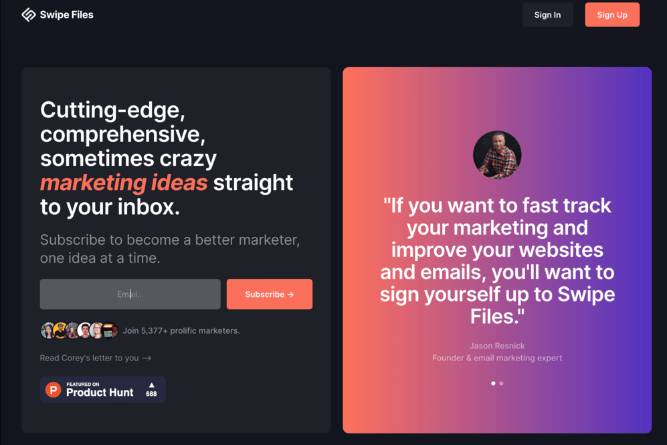Plus, discover how much you can earn as a direct-response copywriter – and how to become one.

Do you want to learn how to write direct-response copy that gets your readers to take action? Whether you’re a copywriter or a brand wanting to increase your conversions, you’re in the right place.
Direct-response copywriting incentivizes your reader to act immediately. Whether that means buying a product, signing up for a workshop, inputting their email address, or more.
Effective direct-response copy directly leads to sales and conversions. So, it’s a highly valuable skill to master for yourself and your clients.
If you can show how much revenue your copy generates, you can charge more and attract more copywriting clients.
I’ve spent years mastering the art and science of direct-response copywriting. I’m proud to say my copy is responsible for over $27 million in the service sector.
This number is particularly notable because services are much more challenging to scale than products. A product-based brand can create a product once and sell it many times. Whereas services brands deliver an actual service that requires time, employees, and infrastructure.
I’ve also written sales-driving copy for my clients and managed millions of dollars in ad spend. (One of the primary forms of direct-response copy). So, I know a thing or two about how to write copy that converts. 😉
Now – I’m going to show YOU how to master this lucrative skill. Are you as excited as I am?
Here’s what you’ll learn in this article:
I. What Is Direct Response Copywriting?
II. How to Write Direct-Response Copy
III. Direct Response Copywriting Examples
IV. How to Become a Direct Response Copywriter
You’ll come away knowing exactly how to write effective direct-response copy. And how to kickstart your career as a direct-response copywriter. Let’s get started!
Learn How to Build a Lucrative Freelance Copywriting Career
Get my free copywriting masterclass that walks you through exactly how I went from zero to consistent five-figure months with copywriting – with no experience and no portfolio.
Gain instant access – right to your inbox – when you sign up below. 👇
We will never spam you or share your email with anyone. In addition to the guide you’ll also receive semi-regular email updates with tips, tools, offers and exclusive resources. All emails include an unsubscribe link, you may opt-out at any time. Read our Privacy Policy to see how your data is handled.
What Is Direct-Response Copywriting?
Imagine you’re cooking dinner one night for yourself and/or your family. You Google a recipe, find an article that looks tasty, and hop into the page.
As you scroll down to find the recipe, an ad for the new stainless steel pot you’ve been wanting pops up. How’d they know?!
The ad communicates how the pot would make your cooking easier – and look pretty in your kitchen. Before you know it, you click “buy now” and head to the site to purchase.
This is an example of direct-response copywriting at work. The copy on the banner ad prompted you to click right away.
Some other forms of marketing don’t incentivize an immediate response – such as a poster on the subway or a television ad. TV ads create brand awareness, but there isn’t an option to click “purchase” or immediately buy the product.
In comparison, direct-response copy compels you to take action right then and there. Usually with a call to action button or link.
The action could be to buy the offer. But it could also be to sign up for an email list, register for an upcoming workshop, or much more. Stick around because we’ll dive into real-life direct-response copywriting examples in a bit!
Here are a few formats where you would usually use direct-response copy:
Landing Pages.
A landing page is a standalone web page that compels the reader to take one specific action. Like a sales page where someone can purchase a product or an opt-in form where the reader signs up for the email list.
Direct-response copy is a key element of landing pages because the copy compels the reader to take the desired action.
Ad Copy.
You know when you’re scrolling Instagram, and suddenly an ad pops up in your feed? Maybe the ad piques your interest and gets you to click through to the purchase page.
Social media ads like Facebook, Instagram, and Pinterest ads use direct-response copy to incentivize an immediate action. Ads almost always include a button where you can purchase the product or sign up for an email list.
Email Marketing.
Email is one of my favorite channels because you can have a casual, engaging, and direct conversation with your audience. This is another place where you’d use direct-response copy to prompt clicks and engagement from your reader.
Some forms of email marketing are more sales-heavy than others. But it’s beneficial to always include a call to action in your emails (yep, even nurture emails like newsletters!).
Website Copy.
Certain elements of your website focus on brand awareness vs. direct action. Like your unique value proposition or mission statement. But your website’s ultimate job is to compel your reader to work with you or buy from you.
So, you would use direct-response copy on your site. Especially in places that compel the audience to book a consultation, buy a product, or take another action.
Blog Writing.
An SEO blog’s first job is to drive traffic and get in front of your reader. But once they’re on the page, a blog is another place to incentivize your reader to take action.
Usually, a blog answers a question or solves a problem. Position your offer as the solution to that problem – and then prompt the reader to engage. Actions that fit well within blogs are to book a service, sign up for your email list, or buy something.
The truth is most forms of copywriting fall under the umbrella of direct-response copywriting.
This is what differentiates copywriting vs. content writing. Content writing solely educates the reader on a subject. Whereas copywriting compels the reader to take action.
In my opinion, direct-response copywriting is more valuable than content writing. Because it leads to conversions, sales, and results for a brand. And when you show the results from your copy, you also get paid more as a copywriter.
How to Write Direct-Response Copy (5 Key Elements)
Now you know that direct-response copy should persuade your reader to take action. But how do you actually write action-driving copy?
It’s important to build trust, empathy, and credibility before jumping right into asking your reader to buy. There are tactics to help you build your sales argument and make your call-to-action effective.
Here are five key elements of how to write direct-response copy:
- Credibility.
Your readers want to trust you and your offer before they decide to take action. Demonstrating your credibility builds the reader’s confidence in you.
One of the most effective ways to show credibility is with social proof, like testimonials. You can also outline results, case studies, and client stories.
- Features and Benefits.
The key to direct-response copy is to resonate with both logic and emotion. An effective way to do so is by communicating the features or facts about the offer. And then describing the larger benefits or why that feature matters to the person’s life.
For example, you might say, “Download this list of 7 plant-based recipes [feature] so you can live with more energy, mental clarity, and improved mood [benefit].”
- Empathy.
You want to communicate how your offer solves your reader’s need or pain point. But it’s important to not take advantage of their pain or make them feel worse.
Learn to ethically resonate with pain points by showing big empathy towards your reader. Show them you understand what they’re going through and genuinely want to provide an answer to their problem.
- Value Exchange.
A reader is more likely to take action if it’s clear what they’re receiving in exchange. So, how do you incentivize someone if they’re not buying a product they’ll receive?
This is why many marketers will offer a free, helpful piece of content in exchange for an email address. The reader wants to enroll to receive the valuable information.
- Urgency and Scarcity.
So, your reader is interested in your offer. Why should they decide to take the next step right now? Your direct-response copy should instill urgency to act right away.
You could make it clear that there’s limited stock or limited time to get in on the offer – or both. Your audience is more likely to want something if it won’t always be available.
Depending on the length of your direct-response copy placement, you may use some or all of these tactics. These methods build a compelling sales argument for your reader.
At this point, you’ve empathized with their pain points, shown how your offer can solve their problem, demonstrated your credibility, and given them a reason to act now.
The final step is to direct them to a call-to-action (CTA).
This may sound obvious, but it’s essential to tell your audience exactly what action to take. Make it clear and compelling with a button, link, or opt-in form.
Direct-Response Copywriting Examples
All right, all these tactics sound great in theory. But how do you actually apply these tactics to value-driven, conversion-driving, direct-response copy?
Let’s go through some real-world direct-response copywriting examples so you can see these techniques in action. To demonstrate, I’ll analyze a few different opt-in landing pages. These types of landing pages compels the reader to enroll in a brand’s email list.
Here’s the first email opt-in example from Swipe Files:

- The headline clearly states exactly what the audience gets from the newsletter [cutting-edge marketing ideas]. And it also communicates the benefit, aka why that’s important to them [become a better marketer].
- Instead of telling them their own story for credibility, this uses testimonials as social proof to demonstrate credibility.
Here’s another opt-in landing page example from author and life coach Jen Sincero:

- Jen’s opt-in form communicates exactly what the reader is going to receive by joining her email list: “advice, inspiration and loving, yet firm, motivational spankings from Jen.”
- She also includes a valuable piece of content in exchange for your email address: “10 Secrets to Being a Badass.” A freebie is a popular tactic because it prompts reciprocity. You give away free information for their benefit to kick off a solid relationship.
I hope these examples show you that there’s not ONE right way to do things in direct-response copywriting. One of these landing pages used stats to build their credibility, and another used social proof. Yet both are effective and compelling.
There are different ways to write successful direct-response copy when you use the general points of persuasion and effective copywriting.
That’s why I always tell my copywriting students to learn the rules of copy so that you can break them like a pro.
How to Become a Direct-Response Copywriter
If you’re considering becoming a direct-response copywriter, there may be a few things you’re wondering about before you dive in. Like “how much do copywriters earn?” and “how do I land copywriting clients?” So, let’s dive into ‘em.
Direct-Response Copywriting Salary
The content you create could generate thousands or even millions of dollars per year for your client. Your copywriting fee is only a small fraction of your client’s revenue. So, it’s well worth it for a brand to invest in your services.
I always like to be very transparent, so here’s an actual example of the direct-response copywriting salary you can earn.
One of my past copywriting clients was an e-commerce brand in the medical industry. We worked on a $21,000 monthly retainer agreement for over a year.
Each month, this client paid $21,000 for high-quality, conversion-driving copywriting. The monthly retainer fee was valuable because the content generated millions of dollars in revenue for their brand.
5 Steps to Become a Direct-Response Copywriter
To become a high-earning copywriter, you need more than skills alone. So, let’s talk about how to showcase your work and land high-paying clients.
Here’s a breakdown of how to become a freelance copywriter:
- Learn copywriting skills. It’s important to spend time learning copywriting techniques, persuasion, and formulas so you can generate results for your clients.
After reading this blog, you have a good basis of direct-response copywriting techniques. But you may want to explore taking an in-depth copywriting course and reading a few books on the subject. - Choose a copywriting niche. If you’re really interested in direct response copy, you may want to explore e-commerce as your copywriting niche. Brands that sell products and services online need direct-response copy to sell those offers.
E-commerce exists in almost every industry, so you could still narrow it down to one area like health and wellness, for example. You could write for wellness brands and/or coaches that sell physical or digital products. - Create a copywriting portfolio. You don’t need prior experience to become a copywriter. But potential clients want to read your writing samples. So, start creating a copywriting portfolio by practicing writing and self-publishing.
If you don’t have any clients yet, then simply think of a product you’re interested in and pretend you’re promoting it! Practice writing a direct-response copywriting piece for the product – like a landing page, social media ad, or article. - Land copywriting clients. After you practice your skills, it’s time to find copywriting clients. Two primary forms of client acquisition are cold pitching and networking.
Getting clients is crucial to creating a lucrative freelance writing career. So, I’ve dedicated an entire section on this below.
- Showcase your results. As you start working on direct-response copy projects, always follow up for results. Results are key because they show how your copy performs and how much revenue it generates.
Let’s take an email project, for example. Ask for the average email open rates, click-through rates, and unsubscribe rates. Showing these numbers to potential clients builds credibility.
You could follow these steps to get a job as a direct-response copywriter at a brand or agency. But creating your own client base as a freelance copywriter offers you more flexibility.
It’s so, so worth it to have the freedom to create your days, workload – and even your salary.
If you’re looking to demystify the process of creating a lucrative freelance copywriting career, check out my free copywriting masterclass. You’ll learn the exact steps to start a career as a direct-response copywriter in three months or less.
How to Land Direct-Response Copywriting Jobs
Okay, so you’ve decided to pursue freelance copywriting and build your own client base. Where do you find high-paying clients?
Here are a few ways to land direct-response copywriting jobs:
- Cold Email. The top strategy I teach my copywriting students is to cold email clients and brands you want to work with. This is how you communicate the value of your services – and position yourself as an expert.
- Social Media Ads. If a brand runs social media ads, this is a sign that they have a marketing budget. If you see an ad that compels you, direct message the company. Ask them if they’re open to testing out a new copywriter.
- LinkedIn and/or Twitter. Start networking and posting content on LinkedIn or Twitter to organically interact with brands and build your authority. This is a long-term strategy and may take a few weeks or months to see a return.
It starts to get easier after you land your first few copywriting projects. As you make connections and build your credibility, you start to get referrals and returning clients!
Become a Direct-Response Copywriter
Do you want to skip the confusion and get the exact roadmap to become a direct-response copywriter in the next three months?
My course, Write Your Way to Freedom, is the fast track to building a lucrative freelance copywriting career. One that fulfills you and enables you to create the life you want. 🙌
Write Your Way to Freedom includes curriculum, coaching, and community to help you reach your goals faster. You’ll learn exactly how to…
- Learn copywriting skills that get results for your clients. So you can charge more and feel confident in your skills.
- Land direct-response copywriting clients you love. Through different tactics like cold emailing or networking.
…and much, much more.
Apply for a strategy session to learn how Write Your Way to Freedom can teach you how to become a direct-response copywriter in the next three months.







